During the ISU Grand Prix of Figure Skating series you could see a lot of popular and familiar faces not only on the ice, but also at the boards and in the Kiss & Cry. Many former top skaters have turned to coaching and now travel with their students to competitions such as the ISU Grand Prix events and ISU Championships that some of them have attended themselves not so long ago. We met some of them as the Grand Prix circuit travelled from one stop to the next in the past six weeks.
Stéphane Lambiel: Passing on the passion
%202010%C2%A9AFP-96767254.webp)
Stéphane Lambiel (SUI) 2010©AFP
With an Olympic silver medal from 2006, two World titles, three European silver medals, Stéphane Lambiel is Switzerland’s most successful figure skater to date. He retired from competing after participating in his third Olympic Winter Games in 2010, where he came fourth and then performed in many shows. At the same time, the now 33-year-old started first choreographing for other skaters and then gradually teaching. Lambiel opened his skating school in Switzerland in summer 2014, first helped out mainly as a consultant, but now is coaching there full-time. He attended the Grand Prix events in Japan and France with his permanent students Deniss Vasiljevs (LAT) and Matilda Algotsson (SWE) and during the summer he choreographed programs for example for three-time World Ice Dance Champions Gabriella Papadakis/Guillaume Cizeron (FRA) and 2018 World bronze medalist Mikhail Kolyada (RUS). Most of his life, Stéphane was taught by Peter Grütter in Geneva, with Salome Brunner as his choreographer.
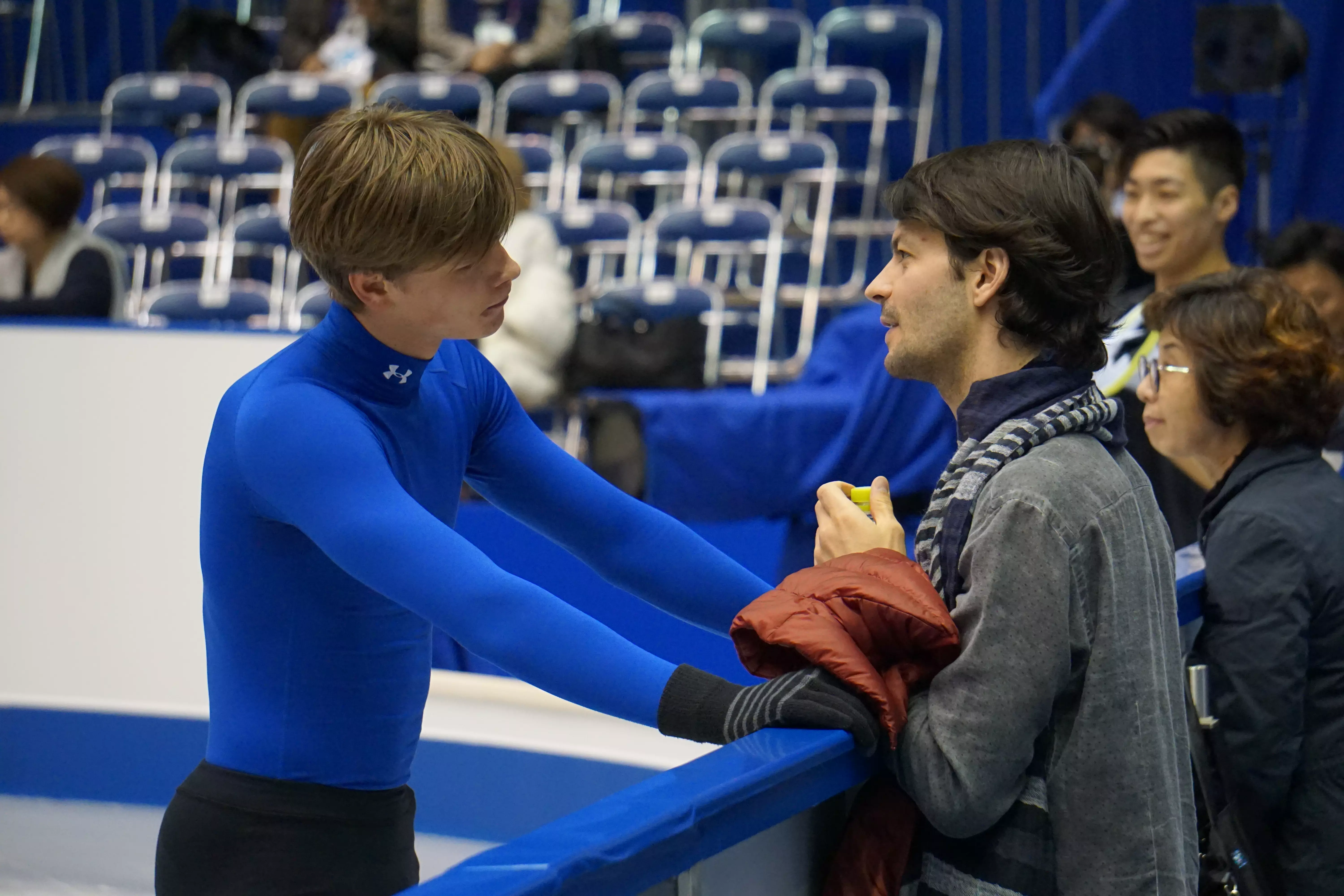
Deniss Vasiljevs (LAT) and Coach Stéphane Lambiel 2018 ©International Skating Union (ISU)
“I learned a lot from Peter and Salome. Salome in fact educated me, because my parents didn’t come from the figure skating environment nor from dance,” Lambiel said. “I had Peter and Salome, who know the artistic ambience very well and Peter is a great skating specialist. He gave me the basics and the confidence in the figure skating environment. They have a great technique, a great base. I think they are really the most precise persons in their work. They have a lot of patience and they are really passing on their passion. Peter works on the steps a lot. And each day he is able to discover a new step, a new move. He never runs out of ideas. Peter has passed on his passion and it is the same for me. I can’t go out on the ice and not do steps. I go out and for ten minutes, I do steps and feel the ice, trace the ice in fact, use the edges. This is so beautiful about skating, it is the technique of the blade, the control,” Stéphane shared.
2006%C2%A9Getty%20Images-56640256.webp)
Stéphane Lambiel (SUI) 2006©Getty Images
Choreographing and coaching is subtle work, in the eyes of Lambiel. “It is about how you will open the door to the skater. This is very difficult. You can’t say, ‘you have to…’ you can’t force them. It should come from within yourself, but I think that the choreographer has the role to push without pressuring to lead to this path of personal interpretation. You have to be honest on the ice. If it is not honest, it could be brilliant, but something is missing. Salome was great for that. She never enforced her own personality, she just guided me. I think this is what you need to do. You have the right to show moves, you have the right to choose music, you have the right to do many things, but eventually the skater is on the ice and he himself has to be honest, natural, he should represent what he wants to represent.”
Brian Orser and the magic wand
1988%C2%A9AFP-142576152.webp)
Brian Orser (CAN)1988©AFP
Canadian Brian Orser was a popular and successful skater, winning two Olympic silver medals in 1984 and 1988 as well as the World title in 1987. After retiring from competing in 1988, he toured and skated in shows for about 17 years before starting his coaching career and one of his first students was Yuna Kim (KOR) whom he coached to Olympic gold in 2010. “During that time (touring and skating in shows) I did a lot of seminars. I was learning teaching of skating and not so much coaching, but teaching. I kind of got the bug for it. I kind of got the feeling that I have a good rapport to the skaters and a good technique to teach them plus I could show them. I don’t know, it (the transition to coaching) did go very smooth and I don’t know why. Maybe just because I have a passion for it. I want the kids to do well, I want to bring out the best in them. And if they’re willing to do that, together we’re just sort of jumping with both feet and we do it,” he said.
%20and%20Brian%20Orser%202015%C2%A9International%20Skating%20Union%20(ISU)-499014272.webp)
Yuzuru Hanyu (JPN) and Coach Brian Orser 2015©International Skating Union (ISU)
Orser, who currently works with top skaters such as Yuzuru Hanyu (JPN), Junhwan Cha (KOR), Evgenia Medvedeva (RUS), Jason Brown (USA) and is also Javier Fernandez’ (ESP) long-time coach, points out that he has a very good team around him. “I’m not a one-man show. I have Tracy Wilson who does an amazing work,” he noted. Other members of his team in Toronto are for example Ghislain Briand and choreographer David Wilson. “I don’t know if I have a philosophy. I think it’s just communication,” Orser shared. “We have a style, a technique that we really enforce and we hope that the skaters buy into it. It takes time, it takes patience and we don’t do the quick fix, and I don’t have a magic wand. I think it’s just communication and keeping a really positive environment. I think that is really my philosophy – I try to make sure that everybody is ready, whether that is costumes or music, choreography and levels, all those things. I surround myself with great people. That’s my philosophy.” Brian Orser’s students Hanyu and Cha qualified for the ISU Grand Prix Final.
Artur Dmitriev: The power of pair skating
%201998%C2%A9Bongarts-52843928.webp)
Oksana Kazakova and Artur Dmitriev(RUS) 1998©Bongarts
Russia’s Artur Dmitriev is the first and so far only male pair skater to win two Olympic gold medals with different partners: In 1992, he became Olympic Champion with Natalia Mishkutenok and six years later he took gold again with Oksana Kazakova. Dmitriev, who has lived a few years in the USA, then returned to Russia and started coaching Pairs first in St. Petersburg and for the past few years in Moscow. Most recently, he coached 2018 Olympians Kristina Astakhova/Alexei Rogonov, who meanwhile split up, and has taken several young teams under his wings. However, at the Rostelecom Cup Dmitriev coached his son Artur Dmitriev jr, 26. Artur junior tried a quadruple Axel at the event. He missed it, but he was the first to attempt this jump in competition. “We need to push skating forward. We’re trying new things,” said his father. They also included the unique combination of triple Lutz-triple flip in the Short Program. As a skater, Dmitriev senior was also pushing the limits technically and artistically. With Kazakova, he was working on a quadruple throw toeloop for example.
Florent Amodio: Teaching how to charm an audience
2016%C2%A9International%20Skating%20Union%20(ISU)-507766778.webp)
Florent Amodio (FRA)2016©International Skating Union (ISU)
2011 European Champion Florent Amodio of France was for many years a popular skater on the skating circuit, taking many medals, but his career had also a lot of ups and downs. He retired from competing after the ISU European Figure Skating Championships 2016, has started coaching and collaborates with his former coach Nikolai Morozov. “I want to help figure skating. It always has been my biggest goal to push the sport forward and to leave a trace.
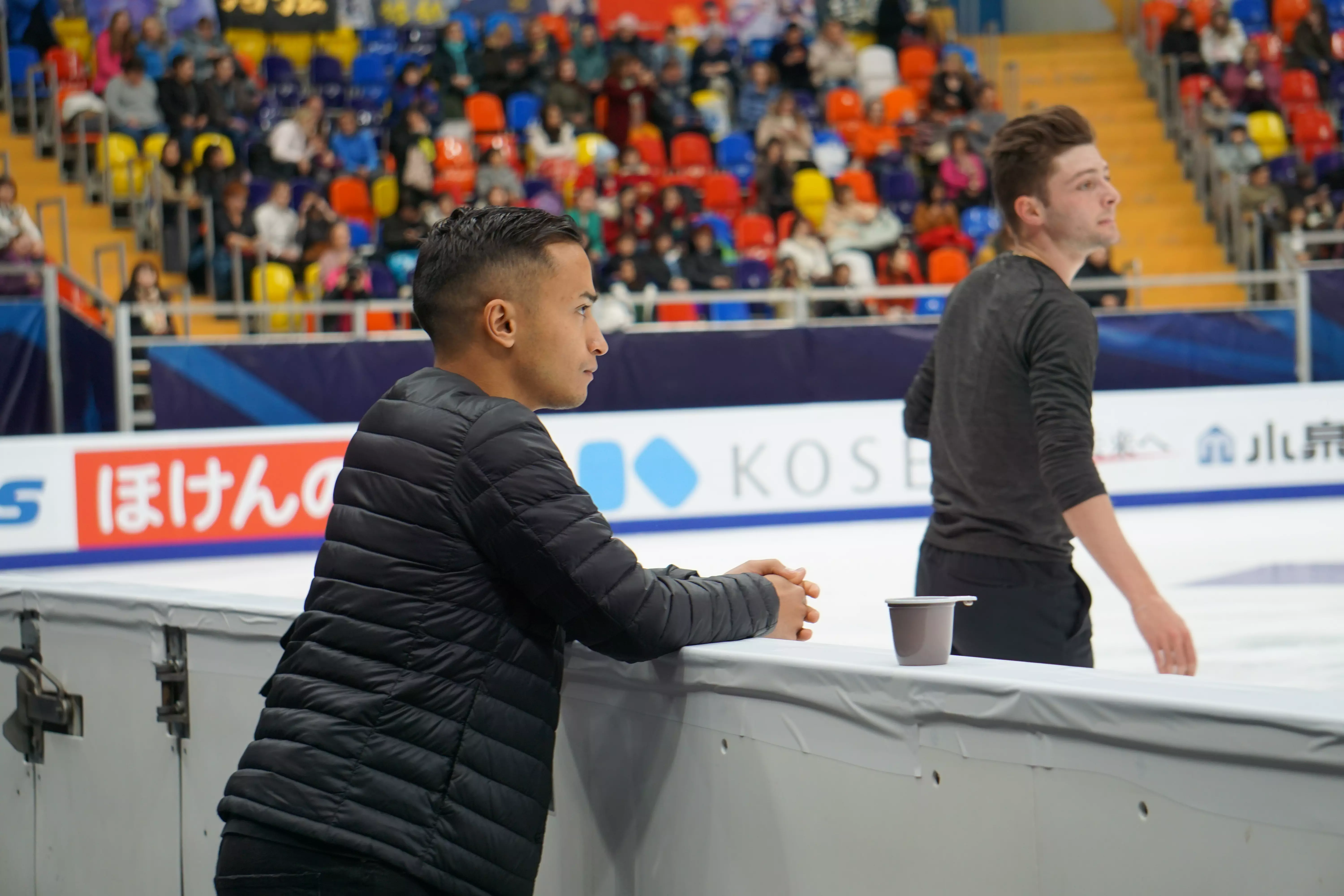
Coach Florent Amodio with Brendan Kerry (AUS) 2018©International Skating Union (ISU)
I want to teach the young generation how to charm an audience. I am impressed how they do quads as if they were triples, but you should not forget that people come to watch a show. It is now my time to give back something and to share my experience,” Florent said. He is teaching in Vaujany in France and one of his students is Brendan Kerry (AUS), with whom he was in Moscow at Rostelecom Cup.
Marie-France Dubreuil and Patrice Lauzon: Building a dance empire
2006%C2%A9AFP-73663940-57146624.webp)
Marie-France Dubreuil/Patrice Lauzon (CAN)2006©AFP
Marie-France Dubreuil/Patrice Lauzon stood in the long tradition of successful Canadian Ice Dance couples and won back-to-back World silver medals in 2006 and 2007 before retiring from competition. They got married in 2008 and have a daughter, Billie-Rose. In 2010, the Canadians founded their own Ice Dance school in Montréal that has grown fast. At the 2018 Olympic Winter Games, Marie-France and Patrice and their team coached among others the gold medalists Tessa Virtue/Scott Moir (CAN) and silver medalists Gabriella Papadakis/Guillaume Cizeron (FRA). At this season’s Grand Prix, not less than nine dance couples from the Montreal school competed. Among them are Madison Hubbell/Zachary Donohue (USA) and Kaitlin Hawayek/Jean-Luc Baker (USA), who qualified for the ISU Grand Prix of Figure Skating Final. Right now, a total of 18 teams from nine countries are training in the Montréal school.
%20and%20coaches%20Marie-France%20Dubreuil%20and%20Patrice%20Lauzon2018%C2%A9Getty%20Images-921167786%20(1).webp)
Tessa Virtue and Scott Moir (CAN) and coaches Marie-France Dubreuil and Patrice Lauzon2018©Getty Images
“When we started the school, it wasn’t the idea to make it the biggest school in the world. It was more, we had to move outside of Canada to train. I was a little frustrated that we had to move and couldn’t train in Canada, one of the biggest skating countries in the world. Montreal and surroundings there are about 300 ice rinks. It started slowly, we had a few teams, then it started growing and then it exploded,” Patrice Lauzon said. The head coach feels that it is an advantage for his students that so many high-level teams train together. “For them, it’s to be to be able to train with their competitors every day. Everybody pushes each other. Training is hard. Ice dancers are a lot on the ice, have many run-throughs. When you have your closest competitors there, they encourage you, they are applauding when you do something nice and when you have a bad day, they’re helping you through. It helps a lot and everybody gets better. That’s what I like the most about my job, even more than being at the Olympics or Worlds – is watching them every day at the training center, pushing each other and encouraging each other, seeing them passing their limits,” he continued.
Anjelika Krylova: A new beginning in the old home
1998%C2%A9AFP-51636912.webp)
Goodwill Games Oleg Ovsiannikov and Anjelika Krylova (RUS)1998©AFP
Anjelika Krylova of Russia is very well remembered as an expressive and technically brilliant Ice Dancer. With partner Oleg Ovsiannikov, she won the silver medal at the 1998 Olympic Games and two World titles in 1998 and 1999, but then she retired from competing because of injuries. Anjelika soon focused on her coaching career and built with Pasquale Camerlengo, a former Italian Ice Dancer she got married to, a dance school in the Detroit area. After 24 years of coaching in the USA, Krylova moved back home to Moscow in spring 2018 with daughter Stella and son Anthony and has opened a new school together with her colleague Oleg Volkov.
%20and%20coach%20Anjelika%20Krylova%202014%C2%A9Getty%20Images-481242277.webp)
Coach Pasquale Camerlengo, skaters Andrew Poje and Kaitlyn Weaver (CAN) and coach Anjelika Krylova 2014©Getty Images
She now tries to combine the North American and the Russian way of training. “In these many years of coaching I have accumulated a lot of experience and I want to pass on my knowledge to our athletes. The training system there (in the USA) and here (in Russia) is different and it is hard to change. We have a group system, there they have an individual teaching system. I think that the individual system is more progressive for ice dance in the future,” she noted. “Obviously, individual sessions exist, but when the athletes reach the level of the national team and a big group has been formed, the question of individual training comes down to the amount of time and ice,” she added. “I’ve seen a lot of children in Russia that you can form into good athletes. I want to raise a new generation of high-level athletes. The potential in Russia is huge, there are many interesting and creative experts in all disciplines and this you have to use in figure skating. There are a lot of opportunities here, you just need to use them the right way.” At the Grand Prix series, Anjelika coached Betina Popova/Sergey Mozgov (RUS).
Bruno Massot: Following his dreams
2017%C2%A9International%20Skating%20Union%20(ISU)-888702616.webp)
Aljona Savchenko and Bruno Massot(GER)2017©International Skating Union (ISU)
A year ago, Bruno Massot was still competing with Aljona Savchenko and the German pair crowned their career with Olympic gold and the World title in 2018. While the Pair Skaters keep their options open and meanwhile perform in shows, Bruno has started coaching as he always wanted and helps his long-time coach Jean-Francois Ballester, who is based in Switzerland. Massot travelled with the Austrian pair Miriam Ziegler/Severin Kiefer to the Grand Prix in Moscow. “It (coaching) is a different kind of work, but we’re still in the middle of our passion and do what we love. It is different, but it is a good experience,” Bruno said. “For me, it is a lot less stress (than competing). I am helping and I give advice, but in the end, it’s in the hands of the skaters. They need to do the job. I already did my job.” He laughed. „I love what I’m doing. It is very nice to pass on my experience and to share something.”
Maxim Trankov: “I wanted to run away from figure skating”
2016%C2%A9International%20Skating%20Union%20(ISU)-518765484.webp)
Tatiana Volosozhar and Maxim Trankov (RUS)2016©International Skating Union (ISU)
Russia’s Maxim Trankov is another Olympic Pair Skating Champion, who now can be seen at the boards, coaching the Russian Champions Evgenia Tarasova/Vladimir Morozov. However, coaching wasn’t really in his plans. “I wanted to run away from figure skating, even from shows and everything, for a long time, because I don’t like skating, to stress out, to go to training every day. I never liked that and I don’t like it now. I never was a fan of figure skating and that is not a secret,” Tankov revealed. In addition to coaching the couple on skates on the ice, he performs with his skating partner and wife Tatiana Volosozhar in shows. “I thought after I won the Olympic Games that I’ll never have to skate that much again and that will be great, but it turned out that I’m skating even more.”
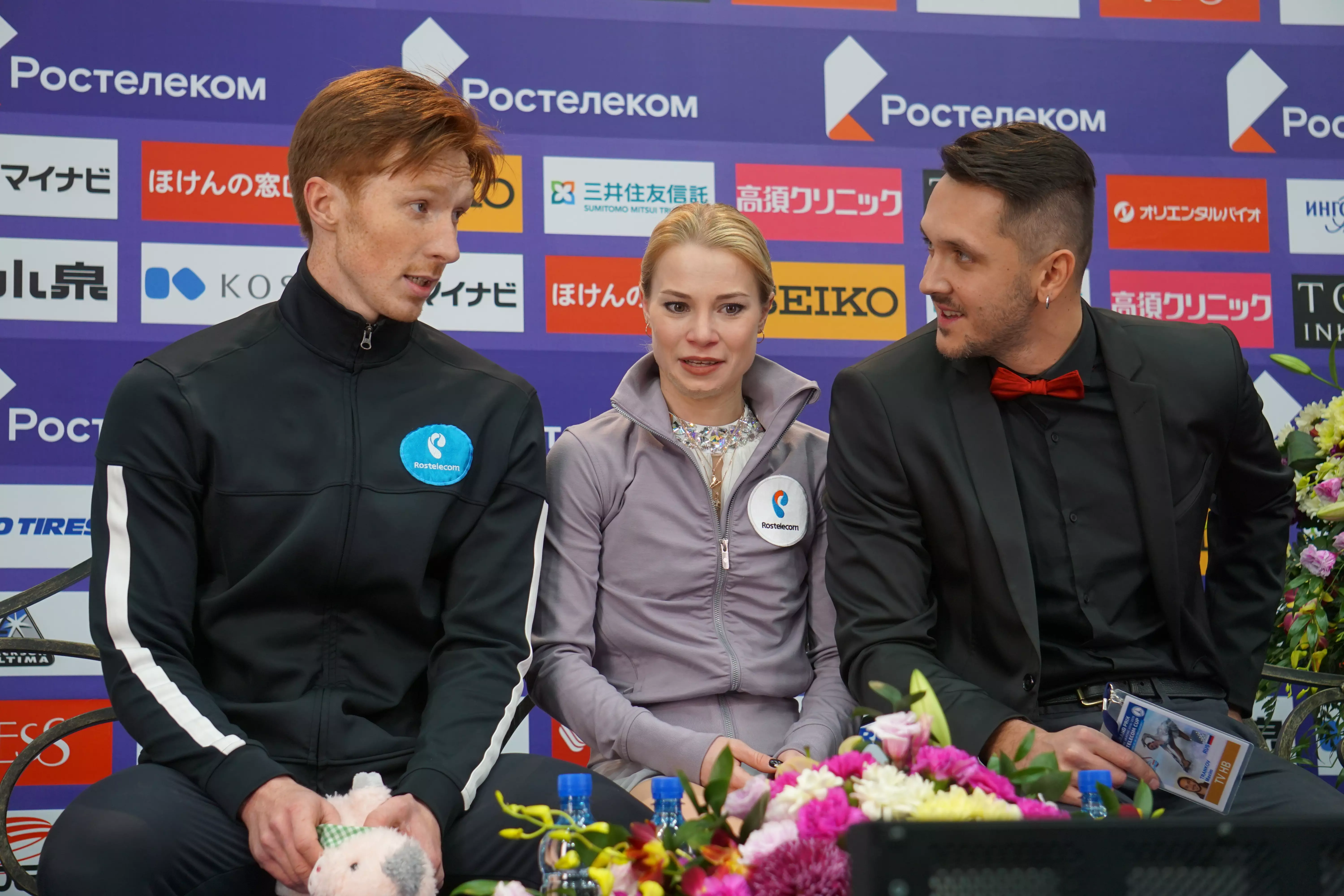
Evgenia Tarasova/Vladimir Morozov (RUS) with Coach Maxim Trankov 2018©International Skating Union (ISU)
Nevertheless, Maxim couldn’t say no to Evgenia and Vladimir. “I agreed mostly, because it is another challenge for me and also because I couldn’t decline their request, because they are my friends and they grew up in front of our eyes at our rink,” he explained. “They were weighing the options for a long time. They had experience working with me and they liked it back then and therefore they chose me.” Although other pairs asked Trankov to coach them, he turned them all down.
Hongbo Zhao: Continuing the path
%202010%C2%A9AFP-96733828.webp)
Xue Shen and Hongbo Zhao(CHN) 2010©AFP
Xue Shen/Hongbo Zhao of China made figure skating history as the first Chinese pair to win medals at the World and Olympic level. They won the World title in 2002 and in 2007 as well as two Olympic bronze medals and finally Olympic gold in 2010. Zhao then followed in the footsteps of his coach Bin Yao, who is the father of Chinese pair skating as he built up the discipline in the country.
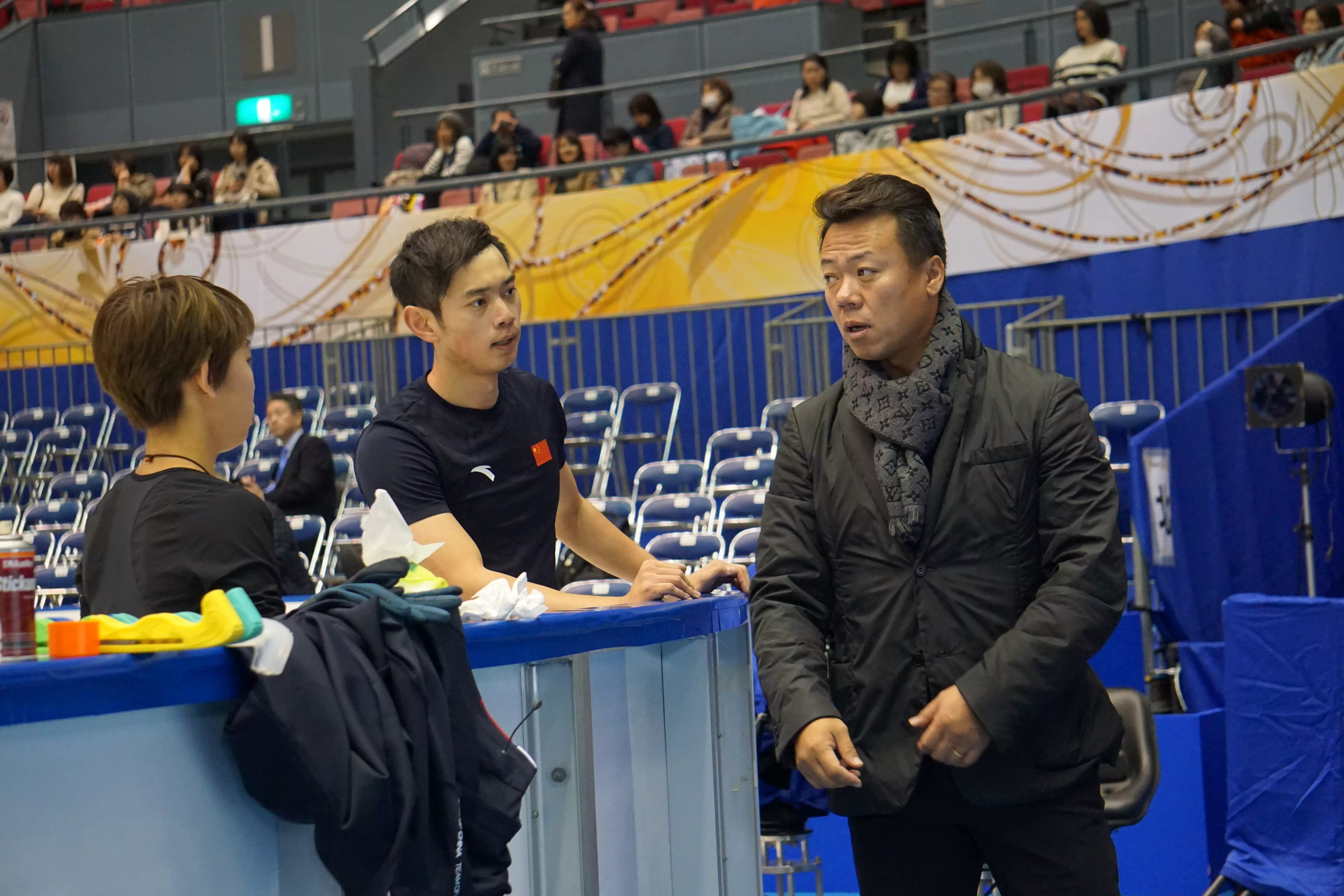
Coach Hongbo Zhao with Cheng Peng/Yang Jin (CHN)2018©International Skating Union (ISU)
Zhao, who married his ice partner in 2007, succeeded Yao as head coach and teaches mostly Pairs. Among them are ISU Grand Prix of figure skating finalists Cheng Peng/Yang Jin and Olympic silver medalists Wenjing Sui/Cong Han.
Viacheslav Zagorodniuk: From Ukraine to the USA

Coach Viacheslav Zagorodniuk and Yaroslav Paniot (UKR)2018©International Skating Union (ISU)
In his competitive days, Viacheslav Zagorodniuk of Ukraine was known for his huge triple Axel. The skater from Odessa won the European title in 1996 and took bronze at the World Championships in 1994. He turned to coaching soon after retiring from competing in 1998 and is now based in Irvine, California (USA). Zagorodniuk coaches Yaroslav Paniot (UKR) and went with him to NHK Trophy in Japan.
Tamara Moskvina and Alexei Mishin: Living legends
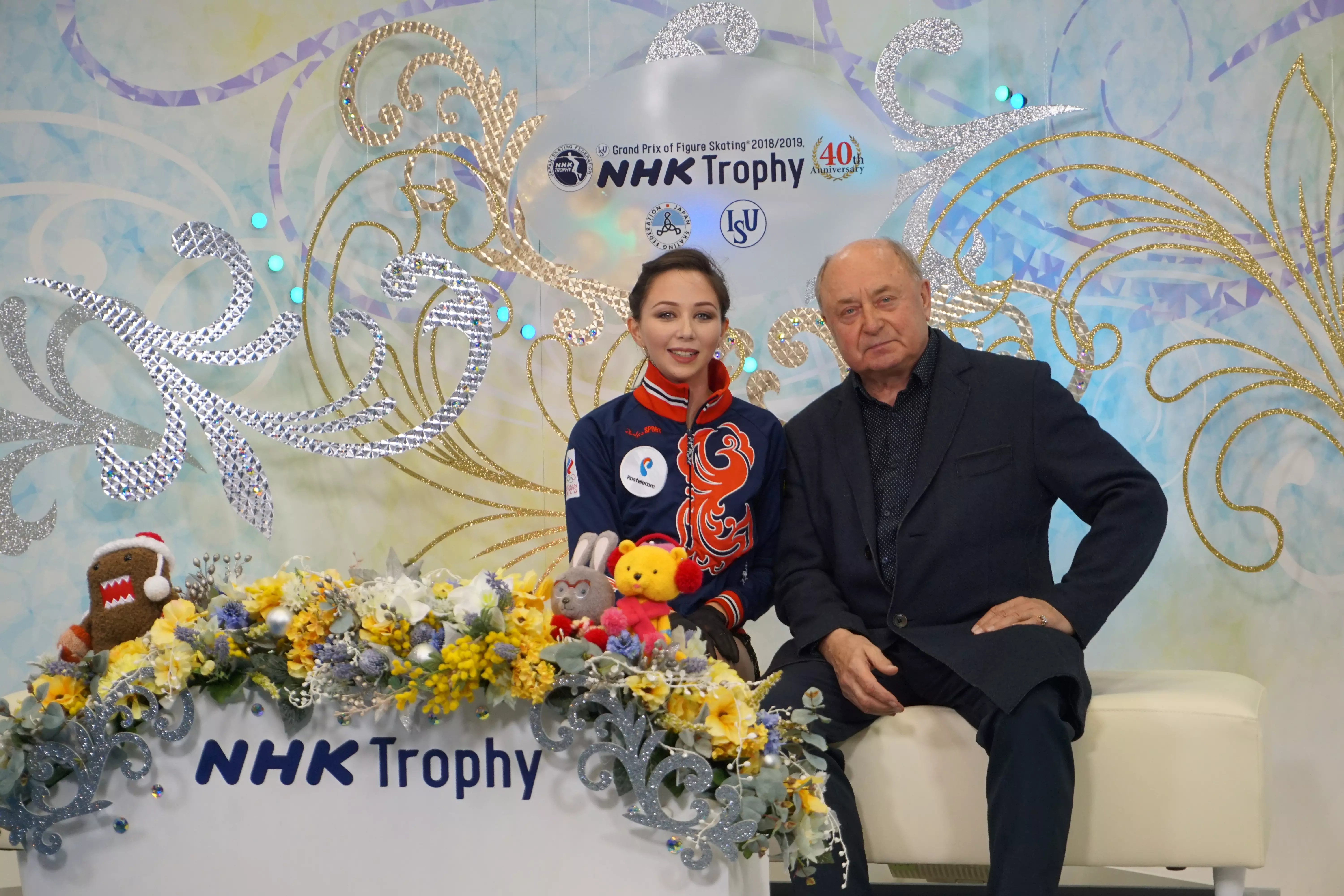
Elizaveta Tuktamysheva (RUS) with Coach Alexei Mishin 2018©International Skating Union (ISU)
Tamara Moskvina and Alexei Mishin are legendary Russian coaches, but they also had a successful career as pair skaters, winning a silver medal at the World Championships in 1969 as well as silver and bronze medals at the European Championships in 1968 and 1969. Both became extremely successful as coaches, among their students are several Olympic and World Champions. Moskvina is a pair skating coach while Mishin coaches singles. At 77 years of age, they are still teaching and coaching and are on the ice almost every day. Mishin’s students Elizaveta Tuktamysheva and Sofia Samodurova qualified for the ISU Grand Prix of Figure Skating Final and the young pairs team Aleksandra Boikova/Dmitrii Kozlovskii that is coached by Artur Minchuk and Moskvina, placed third and fourth in their two Grand Prix events.